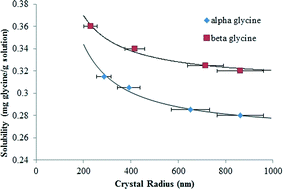Nanocrystal formation and polymorphism of glycine†
Abstract
The surface of a crystal may play an important role in its physical and chemical properties. The percentage of molecules that are exposed on surfaces increases significantly as the crystal size decreases. However, the role of surface molecules and crystal size on the physiochemical properties of crystals is poorly understood. Here, using glycine as a model compound, nano-sized crystals were obtained by two different methods – nano spray drying and bi-functional self-assembled monolayers (SAMs). The surface structures of these nanocrystals were examined and the solubility was measured as a function of size for both the α-form and β-form. In addition, our results indicate that the solubility ratio of β-form/α-form changes as size decreases.


 Please wait while we load your content...
Please wait while we load your content...